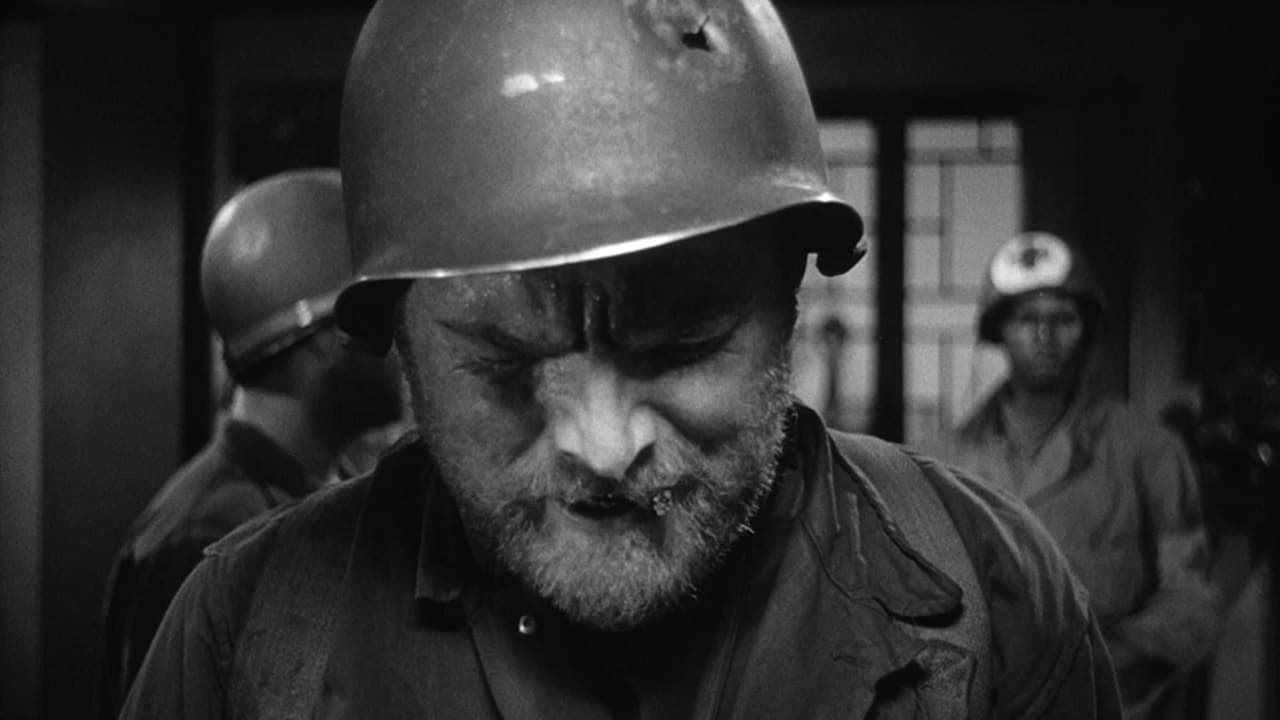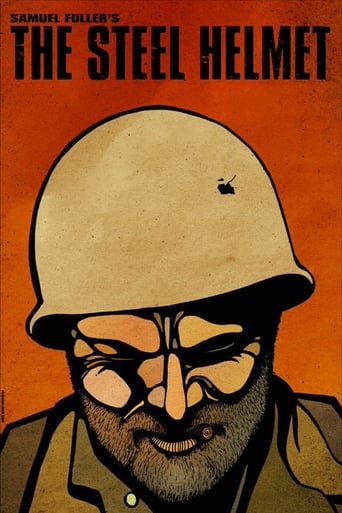

There is so much going on in a Sam Fuller Movie that the Intensity and Density beg for Wordy Discussions and In Depth Analysis. Make No Mistake, this is and has been done for Anyone Interested in this B-Movie Maverick Auteur and His Unique Form of Filmmaking.This is Fuller at His Best and Most Comfortable. He Draws from His War Experience and then Bathes the Real-Life Memories in Philosophical, Street-Smart Dialog. His Characters are Rough and Exaggerated, Full of Flesh and Vinegar, and make for some Engaging Interactions.The Korean War Film Opens (the movie was made as the U.S. was just entering the police action) with a Gruffy, Gritty, Infantry Sgt with His hands (metaphorically) "tied behind his back". Fuller might be saying that this is the way all Wars are Fought by the Grunts. The Film is one Sensational Encounter after another, as Sgt. Zack is Rescued by a South Korean Tween and they "team-up" to make Their way through No Man's Land.Joining the Two Misfits are more Rag-Tags. A Negro Medic who is Reminded that back Home He had to ride in the Back of the Bus, a Conscientious Objector, a 90-Day Act of Congress Lt., a Soldier who Wheezes and has no Hair from Childhood Rheumatic Fever, a Japanese Bazooka Man whose Family was in a WWII Internment Camp, and a Half-Wit who refuses to Speak.No One is without Flaws and Personality in a Sam Fuller Squad. The Movie was Deemed so Sympathetic to Foreign and Subversive Causes that it got Labeled Communist Propaganda by the FBI and Hoover along with Right-Wing Critics. The Director was even called to Washington D.C. to Explain Himself.Overall the Movie is a One of Kind B-Movie Masterpiece and is now Considered a Classic. Uncompromising with that Surreal Fuller Touch it is a Sight to Behold and One can only Imagine just how Powerful it was in 1951. Rousing Climax with a Touching if Hardly Sentimental Ending that is Nothing Like Anything that came before from Hollywood War Films. Essential Viewing and One of the Best War Movies.
... View MoreWhen viewing The Steel Helmet I had to keep reminding myself that this was made and shown to audiences while the Korean War was actually in its earliest stages. Writer-Director Samuel Fuller smartly depicts the relationship of an American soldier and a Korean boy in a non-stereotypical, yet poignant way. Needless to say, it is devastating when the boy is killed in the line of fire. There are some loose ends in this picture, though, that leave the viewer with unanswered questions. For example, it may have helped to know more about what led one of the characters, a conscientious objector, to eventually join the military. Also, viewers would probably like to know what it was like for the black medic to get drafted. His lines regarding segregation and sitting on the back of the bus give us a unique window into another culture. He has come upon foreign land with the hope that civil rights are not only valued back home in the U.S., but also in an Asiatic battlefront threatened by the encroachment of communism.
... View MoreMy parents and I went to see the premiere of "The Steel Helmet" on Hollywood Blvd. in Hollywood, California.My father was a friend of Gene Evans and he had invited us to come and see the movie. I was about 13 at the time and I remember that Gene Evans was very excited about this movie. He was there at the theater to greet us when we arrived. I had always thought that Gene must have been the producer or writer of the movie as he was so proud of it. Ever since then I have looked for Gene in other movies or on TV and have always enjoyed his performances. I would love to get a copy of this movie so that I can see it again. I think I saw it once on TV many years ago. I also liked James Edwards performance in this movie and was saddened to learn that his career was cut short at a relatively young age.
... View More****SPOILERS**** Almost forgotten Samuel Fuller war classic about a group of GI's together with a 12 year-old South Korean boy trapped behind enemy lines in the Korean War. Relased at the time, early 1951, when the US and UN forces were suffering a string of catastrophic losses at the hands of the invading Communist Chinese forces, together with their North Korean allies,the movie doesn't at all tap into the audiences patriotism with flag waving heroic by the GI's but shows them only as just wanting to survive the hell that they find themselves in.Sgt. Zack, Gene Evens, with his hands tied behind his back and a commie bullet through his steel helmet is rescued by this young Korean boy, Willian Shon, whom he nicknames "Short Round". Zack had been captured by the Communist North Koreans and together with his fellow GI's summarily shot in the head but his helmet luckily deflected the bullet where he played dead until his failed executioners left the scene. A loner who's not interested in any human companionship Zack at first tries to go out on his own in the Korean hills and under brush but "Short Round" is so insistent, as well has having lost his parents in he war,that the tough old battle-hardened GI gives in and lets "Short Round " tag along with him.In the course of the film Sgt. Zack and "Short Round" meet up with a number of GI's who were also separated from their units in the brutal and vicious fighting with the Korean Commies. The lost infantry squad makes it's way through the woods to this deserted Buddhist Temple and sets up an observation post, obviously against the Geneva War Accords, to direct artillery fire on the North Korean units in the area.Director Fuller, this at a time when his country was at war, not only keeps any patriotic themes out of the movie about the great and wonderful ideals, like freedom and democracy, that the GI's in the film are supposed to be fighting for and how evil their enemy, the North Koreans and Comunist Chinese, are but actually brings out how Black and Oriental Americans are discriminated against by the very country that there now fighting and, in many cases, giving up their lives and limbs for the United States of America and does it with this sneaky and back-stabbing North Korean POW Major Harold Fung!Fung tries to get black corpsman or medic Cpl.Thompson, James Ewdwards, and Japanese-American Sgt. Tanaka, Richard Loo,to turn against their country and fellow GI's by bringing out how their treated back home only to almost have, as Sgt. Tanaka told the Commie creep, his rabbit teeth smacked out of his mouth one at a time; it wasn't that what Fung was saying was wrong but that the two GI's that it was directed to, Thompson & Tanaka, saw through his so-called concerned for them and knew enough that no matter how bad things was for them and their fellow Black and Japanese-Americans back home the cause that Fung was fighting for would only make their lives even worse not better.The North Koreans getting a bead on just where the US observation post, that's directing murderous artillery fire on them, is and start to move in on it with a series of wild and furious Banzai-like suicidal assaults on the Buddish Temple which by the time the movie is over results in the deaths of almost all of it's defenders including "Short Round". Breaking through the inner perimeter of the Temple the Commies are then stopped cold by the last two persons who you would have expected in the movie to be gong-ho combat hero's, of the group of GI's trapped in it, US Army Medic Thompson and conscientious objector or Chaplin's assistant Pvt. Bronet, Robert Hutton. Sgt. Zack caught up with the horrific fighting and for once having heart-felt emotions for those fighting and dying in the temple along with him with his little friend "Short Round", whom he developed a genuine father and son relationship with, getting killed momentarily loses it thinking that he's back at Omaha Beach in 1944 instead of in Korean in 1951 with him mindlessly mumbling to himself "The only ones on this beach are either dead or about to die".Sgt. Zack's commanding officer Lt. Driscoll, Steve Brodie, whom he never showed any love for takes over behind the machine gun nest from Pvt. Bronte, who was mowing down the attacking North Koreans, after he was hit and killed by a commie bullet and is soon also shot dead but only after he, and later Cpl. Thompson, courageously held off the surging commie hoards long enough for a US Army infantry squad to break through, the Communist North Korean encirclement, and rescue the remaining GI's.Stumbling out of the battered Buddhist Temple and into formation together with Cpl. Thompson Pvt. Baldy( Richard Mohanan) & Sgt.Tanaka, the only survivors of this holocaust, Sgt. Zack tearfully replaces his bullet riddled steel helmet with that of Lt. Driscoll's on the graveside marker where he was buried; an act that he felt he owed him since he refused to trade helmets with Lt. Driscoll when he was still alive.Powerful war movie that you never get tired of watching not just because of the many great battle action scenes in it but the message that it brings out to it's audience, like in the timeless anti-war classic "All Quite on the Western Front", that war isn't to be looked forward to or celebrated but to be avoided at almost all costs and only to be fought when it's absolutely necessary for the survival of the people nation and freedoms of those who have ,or volunteer, to fight it.
... View More